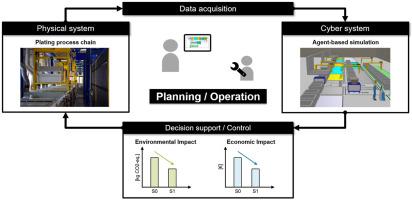Journal of Cleaner Production ( IF 9.7 ) Pub Date : 2020-11-19 , DOI: 10.1016/j.jclepro.2020.125160 Alexander Leiden , Christoph Herrmann , Sebastian Thiede

|
Plating process chains are characterized by a high specific energy and resource demand as well as a high complexity due to dynamic interdependencies between and within processing steps. Planning and operating plating process chains should focus on aspects from cleaner production such as a high energy and resource efficiency, low impacts on the environment as well as on economic aspects. A high process transparency is required to meet these objectives and to evaluate the effects of improvement measures. An energy and resource flow simulation can support this by providing a fully parameterizable digital twin of the physical plating line. This simulation is integrated into a cyber-physical production system approach and connected to the IT environment of the plating company for the simulation of real scenarios. For the parameterization of the energy model, continuous and temporal measurements are combined systematically while the resource flow model is parameterized through information from the manufacturing IT systems. The successful implementation at a job plating company with an industrial acid zinc-nickel plating line indicated reachable electricity and resource savings of up to 10 % in four scenarios. The electricity and plating metal demand was allocated to single carriers and products as basis for a product-based environmental and economic analysis. Especially in case of different carrier load levels, the energy and resource demand per product varies significant. The developed approach and its successful implementation emphasizes the need of a high process transparency for planning and operating plating process chains to accelerate the shift towards cleaner production.
中文翻译:

网络物理生产系统方法,用于能源和资源的高效计划和电镀工艺链的运行
电镀工艺链的特征在于高的特定能源和资源需求,以及由于处理步骤之间和之内的动态相互依赖性而导致的高复杂性。电镀工艺链的规划和运营应侧重于清洁生产的各个方面,例如高能源和资源效率,对环境和经济方面的低影响。为了实现这些目标并评估改进措施的效果,需要高度的过程透明度。能源和资源流仿真可以通过提供物理镀层线的完全可参数化的数字孪生来支持这一点。此模拟已集成到网络物理生产系统方法中,并连接到电镀公司的IT环境中,用于模拟真实场景。对于能源模型的参数化,连续和时间测量被系统地组合在一起,而资源流模型通过来自制造IT系统的信息被参数化。在一家具有工业酸性锌镍电镀线的作业电镀公司的成功实施表明,在四种情况下,可实现的电力和资源节省高达10%。电力和电镀金属需求被分配给单个载体和产品,作为基于产品的环境和经济分析的基础。特别是在不同的载波负载水平的情况下,每种产品的能源和资源需求变化很大。











































 京公网安备 11010802027423号
京公网安备 11010802027423号